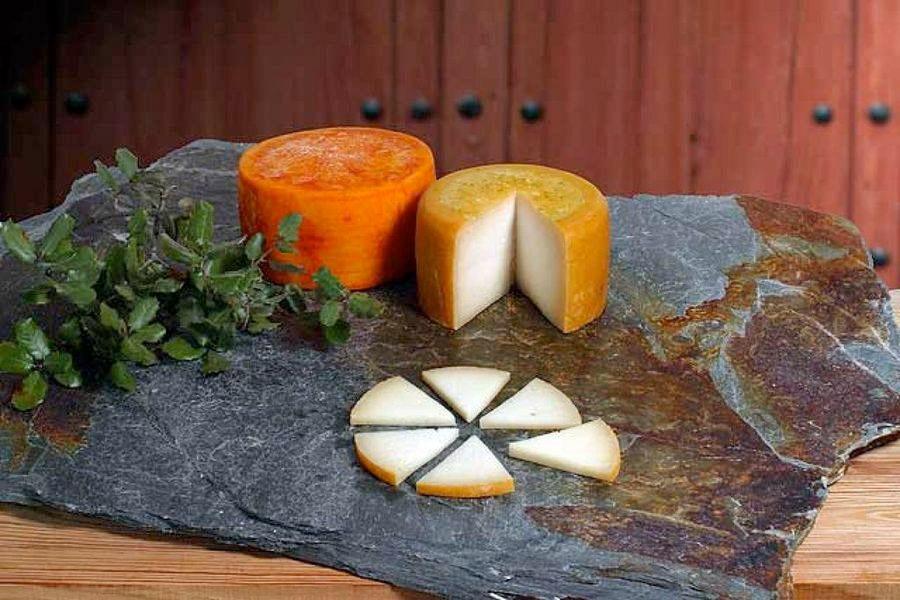Six jewels of the gastronomy of Cáceres that you should try right now
Six jewels of the gastronomy of Cáceres that you should try right now Skip to contentTrends TodayGaliciaValenciaIdeasConsumofinanzas.comInversiónSocial InvestorED LibrosDiario Gol
Ibores cheeses, Jerte cherries, Villuercas honey and, of course, the famous Extremaduran ham are some of the wonders that can be tasted this autumn in Cáceres
Ibores cheese is one of the gastronomic gems of Caceres. Photo PDO Ibores Cheese
Juan Pedro Chuet-MisséOne can travel to Cáceres to be dazzled by its landscapes, fascinated by the heritage of its historic center and marvel at the warmth of the towns of its province.
And there is another way of doing tourism in these lands that no one can resist: gastronomic trips.
It is about exploring the denominations of origin and products with a protected geographical indication, as well as going through different routes to taste the wonders of the gastronomy of Cáceres, such as its cheeses, honey, cherries and peppers.
Aceite de Gata-Hurdes
It is like liquid gold, with a slightly sweet flavor, with a balance between spicy and bitter. Its color is dark yellow, greenish. We are talking about the excellent Gata-Hurdes virgin olive oil.
Its PDO includes 84 municipalities of the homonymous regions, in addition to Trasierra, Tierras de Granadilla, part of Alagón, Ambroz, Jerte and La Vera.
Its cultivation is manual, with respect for the ecology of the steep slopes of Gredos and the Tiétar river trench.
This oil comes from the native Manzanilla Cacereña olive, a fruit of three to four grams, spherical but somewhat asymmetrical, which turns black when ripe.
In the regions you can taste it, and it will be verified that used as a dressing it has properties to treat digestive problems or to eliminate cholesterol.
Cherries from the Jerte Valley
Although they had been known since Roman times, the Arabs introduced the cultivation of cherries in the Jerte Valley, which produces an excellent quality fruit, fleshy and juicy, which seems burst at the first bite.
Read more: Jerte: the beauty of the valley of Extremadura covered with white flowers

Its cultivation spreads to two other valleys, La Vera and Ambroz. One of the most beautiful spectacles in Cáceres is to see these three valleys in spring covered by a white and pink blanket of cherry blossoms.
From May to October, between flowering and cherry picking, Cerecera activities are organized, including tastings, markets and guided tours to discover the secrets of cherries.
Harvesting and grading is done manually, and the day after it is extracted from the tree it arrives in stores with the PDO quality seal.
In these valleys four varieties of the Picota type grow: ambrunés, pico limón negro, pico negro and pico colorado. Difficult to decide on the flavor of one.
Jamón de Extremadura
There is no argument: Extremadura ham is one of the best in the world. But his quality is not the result of improvisation or a miracle of nature.
In order to obtain the Dehesa de Extremadura PDO seal, Iberian pork ham has to comply with a long process.
For example, the young have to drink their mother's milk until they are 60 days old and then feed on feed and grass from the pasture, always in the wild.
Between its 12 and 14 months it consumes between six and ten kilos of acorns a day, along with three kilos of herbs.
The resulting hams and shoulders are divided between that of the acorn-fed pig and that of field bait. The former are classified with a black seal if they are 100% Iberian and red if they are 75% Iberian.
There is also the field fattening pig, fed with feed and natural pastures. In the most exclusive restaurants or in small village taverns you can try the sweet flavor, full of nuances of this ham, which comes in a hue between pinkish and dark red, with its characteristic intermuscular fat.
Villuercas-Ibores Honey
In the southeast of the province of Cáceres, in the regions of Las Villuercas and Los Ibores, hundreds of thousands, millions of bees of the Apis Melliferas variety produce four types of honey of an unforgettable flavor.
One of them is the monofloral chestnut, which is recognized by its penetrating smell and a flavor reminiscent of ripe apples.
Read more: The seven deadly sins of the gastronomy of Extremadura
Another is the monofloral retama. It is an aromatic honey, with a sweet and pleasant flavor, light amber in color with reddish reflections. Its name comes from the collection of the Retama sphaerocarpa flower.
The amber-hued thousandflower can have a slightly sour, salty or bitter taste depending on the main plants that have given rise to it.
And the last one is honeydew or forest honey. It is perceived in a dark color, with reddish reflections, obtained by the libation of chestnuts, holm oaks, cork oaks and oaks.
Pimentón de la Vera
It is said that it was Emperor Charles V who introduced paprika to the Royal Monastery of Guadalupe, from the American lands, and from there it went to the Monastery of Yuste, where religious They used it to preserve sausages.
In La Vera, paprika found its ideal place thanks to its microclimate, where the Capsicum annum species is cultivated, giving rise to three types: sweet, bittersweet and spicy.
Its drying and smoking process is the same as generations ago, with an oak or holm oak firewood that dehydrates the fruits, in a routine that lasts from 10 to 15 days.
This is how it achieves an intense aroma, a unique flavor and an intense, almost brilliant red color, which is used to give intensity to stews, sauces and marinades.
Ibores Cheese
The region of Ibores, which has the highest concentration of goats, is the cradle of one of the most renowned goat cheeses in Cáceres; although its production also extends to the areas of Villuercas, La Jara and Trujillo.
Ibores cheese is fatty, with a semi-hard rind, ivory color, peppered or in oil, produced by the Serrana, Verata and Retinta breeds, raised in the meadows and scrubland.
The local climate and orography means that goats have a low milk production but a high fat and protein content, which gives it its most characteristic properties.
After a maturation process of 60 to 100 days, you can try this cheese with a mild to moderate aroma, buttery flavor, slightly acid, a little spicy, somewhat salty and very pleasant on the palate.
Juan Pedro Chuet-Missé has been a writer for Cerodosbé/Tendencias since 2017, and for Grupo Economía Digital since 2015. He is a specialist in unusual destinations, culture, lifestyle, travel and all those stories worth telling.
Filed in
a.Now on the front page
Slavonia, Croatia's Undiscovered Treasure
Manena MunarCroatia's former granary and winery, the region of Slavonia has a reason to party all year round. We tour this unknown jewel in search of prehistoric cultures, Lipizzaner horses and women in arms
This is the most expensive wine in the world. And it is Spanish
Jordi CatalàAurumRed is a wine from Cuenca that is born with unique care. In addition to the 25,000 euros that the Gold Series can cost, there are exclusive bottles that exceed 340,000 euros
What is behind the success of Louis Vuitton?
Juan Pedro Chuet-MisséThe book ‘Louis Vuitton. Manufactures' explores the craftsmanship in the dozen workshops that the famous luxury brand has in Europe and the US to learn the secret of its success
02B, SL | CIF: B65653164 | Mercantile Registry of Barcelona (volume nº42983 folio 0171, general section, page/dup.417.218, province B, inscrip.2)

